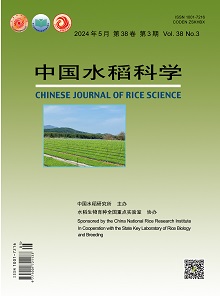【Objectives】The objective of this study was to explore the cultivation method and internal mechanism of alleviating aluminum (Al) toxicity in acidic soil by increasing hydrogen sulfide (H2S) production in rice through sulfur fertilizer application. 【Methods】With the Al-sensitive rice cultivar kasalath as material, six pot experiment treatments were employed: CK (control), CK+S (sulfur fertilizer application), CK+NaHS (H2S donor), Al (aluminum treatment), Al+S, and Al+NaHS. The study measured rice internal H2S content, Al content, antioxidant system enzyme activities at different growth stages, and the indexes related to root growth and photosynthesis during the tillering stage to explore the mechanism of sulfur fertilizer in alleviating the inhibitory effect of Al toxicity on rice growth via an H2S-dependent pathway. 【Results】Compared to the Al treatment, the Al+S treatment significantly increased the H2S content in rice. Specifically, it increased by 19.27% and 34.99% at the tillering and full heading stages in rice leaves, and by 39.72%, 21.08%, and 30.73% at the tillering, full heading, and mature stages in rice roots. Additionally, the Al+S treatment significantly enhanced rice root growth and photosynthesis ability at the tillering stage, while decreasing Al content in rice root, shoot, and leaves at different stages. Specifically, it decreased by 40.98%, 28.47%, and 24.18% at the tillering stage, by 14.58%, 50.30%, and 13.17% at the full heading stage, and by 14.44%, 29.78%, and 8.70% at the mature period. Further studies showed that the Al+S treatment significantly enhanced the activity of antioxidant enzymes (SOD, CAT, APX, POD), reduced the content of hydrogen peroxide (H2O2), malondialdehyde (MDA), and superoxide anion (O2−·) content in rice, increased the relative expression levels of OsALS1 (related to cytoplasmic Al compartmentalization in vacuoles), and increased the relative expression levels of OsSTAR1 and OsSTAR2 (related to cell wall repair damaged by Al). Additionally, the treatment of Al+NaHS displayed similar effects. 【Conclusions】 The application of exogenous sulfur fertilizer increased internal H2S content, alleviating the inhibition to rice root growth and photosynthesis induced by Al toxicity. It also increased antioxidant activity, thereby reducing peroxidation damage induced by Al toxicity and decreasing Al content. Furthermore, exogenous sulfur fertilizer application facilitated cytoplasmic Al compartmentalization in vacuoles, reduced cell wall Al deposition, and altered Al form in the rice rhizosphere, thus reducing Al uptake in rice and mitigating growth inhibition induced by Al toxicity.

